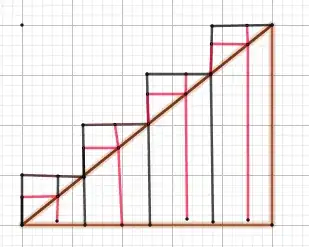The question arose while trying to derive the moment of inertia of solid vs hollow sphere.
In calculating the surface area of sphere, the integral used is $\int{2\pi r×Rd\theta}$.
In calculating the volume of sphere the integral is $\int{\pi r^2 dx}$.
After reading from some related questions: (volume calculation of sphere not working) on this site: I still have a few questions:
In short:
Why is area of cylinder of negligible bulge $=2\pi r\times \text{arc length of bulge }$ ignore radius variation along bulge but volume of cylinder unaffected? We are stacking rings along height of cylinder not along the arc of bulge.To stack against the latter would mean radius of rings changes. Since volume of disc element can be treated as many area of many concentric ring elements and area of each ring element depends on $Rd\theta$ volume should also depend on $Rd\theta$.
In long:
- Why is error in volume of cylinder(disk) with bulging edges negligible while error in area significant?
- If the ring element doesn't change in radius(r) over thickness $Rd\theta$, then shouldn't $Rd\theta$ also tend to $dx$. Then surface area of ring element is $2\pi r Rd\theta=2\pi r dx.$
- If the error in area is significant unless arc length is taken, why don't we account for change in radius(r) of the ring element between the ends of $Rd\theta$? How can the bulge affect the area but not circumference or volume? In other words r should vary between $R\sin\theta \text{ and } R\sin(\theta+d\theta).$
- If $Rd\theta$ gives a better approximation for area then why doesn't it for volume? In the end the sphere is made up of discs. If circumference of disc times $Rd\theta$ is elemental area, then area times $Rd\theta$ is elemental volume but that gives a completely wrong answer instead of a better approximation. If area of something like an elemental trapezium is different from rectangle because of non parallel sides why is the volume of elemental trapezoid prism different equal to elemental cuboid.
- What is the single most accurate formula that takes into account the bulge of the disc,variation of disc radius along bulge and other such factors?
- Is there an intuitive explanation/visualization for all this? It's easy to visualise how area of figures can approach each other without approaching perimeter in proof for $\pi=4$ because error grows but this is difficult.
Ok that may seem like too many questions for a post but they are intricately interwined into each other.
